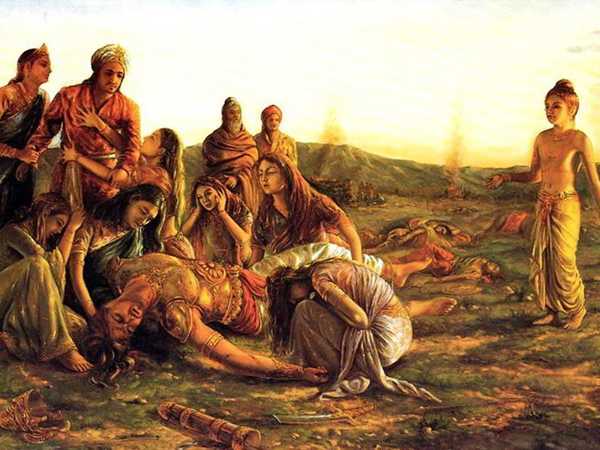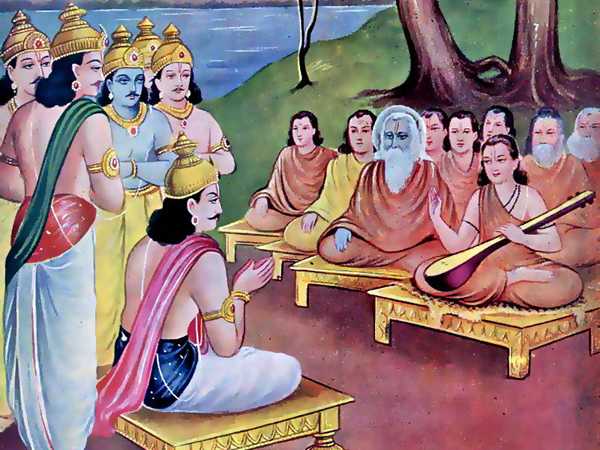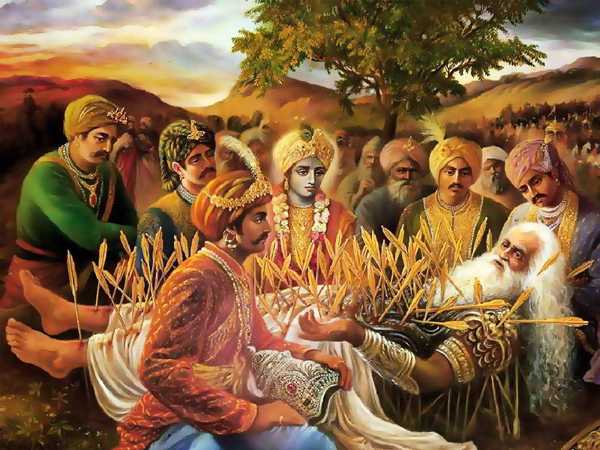Chapter 6

“Dhritarashtra said.—“Thou art intelligent, O Sanjaya, and acquaintedwith the truth (about everything). Thou hast duly given a description ofthe island in brief. Tell us now of the island in detail. Tell us now ofthe dimension of the expanse of land that lies in the portion lookinglike a hare. Thou mayst then speak of the portion resembling peepul tree.”
Vaisampayana said,–“Thus addressed by the king, Sanjaya began to say.
“Sanjaya said,–‘Stretching from east to west, are these six mountainsthat are equal[36] and that extend from the eastern to the western ocean.They are Himavat, Hemakuta, that best of mountains called Nishadha, Nilaabounding with stones of lapis lazuli, Sweta white as the moon, and themountains called Sringavat composed of all kinds of metals.[37] These arethe six mountains, O king, which are always the resorts of Siddhas andCharanas. The space lying between each of these measures a thousandYojanas, and thereon are many delightful kingdoms. And these divisionsare called Varshas, O Bharata. In all those kingdoms reside creatures ofdiverse species. This (the land where we are) is in the Varsha that iscalled after Bharata. Next to it (northwards) is the Varsha called afterHimavat. The land that is beyond Hemakuta is called Harivarsha, South ofthe Nila range and on the north of the Nishadha is a mountain, O king,called Malyavat that stretches from east to west. Beyond Malyavatnorthwards is the mountain called Gandhamadana.[38] Between these two(viz., Malyavat and Gandhamadana) is a globular mountain called Meru madeof gold. Effulgent as the morning sun, it is like fire without smoke.[39]It is eighty-four thousand Yojanas high, and, O king, its depth also iseighty-four Yojanas. It standeth bearing the worlds above, below andtransversely. Besides Meru are situated, O lord, these four islands,viz., Bhadraswa, and Ketumala, and Jamvudwipa otherwise called Bharata,and Uttar-Kuru which is the abode of persons who have achieved the meritof righteousness. The bird Sumukha, the son of Suparna, beholding thatall the birds on Meru were of golden plumage, reflected that he shouldleave that mountain inasmuch as there was no difference between the good,middling, and bad birds. The foremost of luminaries, the sun, alwayscircumambulates Meru, as also the moon with (his) attendantconstellation, and the Wind-god too. The mountain, O king, is endued withcelestial fruits and flowers, and it is covered all over with mansionsmade of furnished gold. There, on that mountain, O king, the celestials,the Gandharvas, the Asuras, and the Rakshasas, accompanied by the tribesof Apsaras, always sport. There Brahman, and Rudra, and also Sakra thechief of the celestials, assembled together, performed diverse kinds ofsacrifices with plentiful gifts. Tumvuru, and Narada and Viswavasu, andthe Hahas and the Huhus, repairing thither, adored the foremost of thecelestials with diverse hymns. The high-souled seven Rishis, and Kasyapathe lord of creatures, repair thither, blessed be thou, on every parvaday.[40] Upon the summit of that mountain, Usanas, otherwise called thePoet, sporteth with the Daityas (his disciples).[41] The jewels and gems(that we see) and all the mountains abounding in precious stones are ofMeru. Therefrom a fourth part is enjoyed by the holy Kuvera. Only asixteenth part of that wealth he giveth unto men. On the northern side ofMeru is a delightful and excellent forest of Karnikaras, covered with theflowers of every season,[42] and occupying a range of hills. There theillustrious Pasupati himself, the creator of all things, surrounded byhis celestial attendants and accompanied by Uma, sporteth bearing a chainof Karnikara flowers (on his neck) reaching down to his feet, and blazingwith radiance with his three eyes resembling three risen suns. HimSiddhas truthful in speech, of excellent vows and austere asceticpenances, can behold. Indeed, Maheswara is incapable of being seen bypersons of wicked conduct. From the summit of that mountain, like astream of milk, O ruler of men, the sacred and auspicious Ganga,otherwise called Bhagirathi, adored by the most righteous, of universalform and immeasurable and issuing out with terrific noise, falleth withimpetuous force on the delightful lake of Chandramas.[43] Indeed thatsacred lake, like an ocean, hath been formed by Ganga herself. (Whileleaping from the mountains), Ganga, incapable of being supported by eventhe mountains, was held for a hundred thousand years by the bearer ofPinaka on his head.[44] On the western side of Meru, O king, isKetumala.[45] And there also is Jamvukhanda. Both are great seats ofhumanity, O king.[46] There, O Bharata, the measure of human life is tenthousand years. The men are all of a golden complexion, and the women arelike Apsaras. And all the residents are without sickness, without sorrow,and always cheerful. The men born there are of the effulgence of meltedgold. On the summits of Gandhamadana, Kuvera the lord of the Guhyakas,with many Rakshasas and accompanied by tribes of Apsaras, passeth histime in joy. Besides Gandhamadana there are many smaller mountains andhills. The measure of human life there is eleven thousand years. There, Oking, the men are cheerful, and endued with great energy and greatstrength and the women are all of the complexion of the lotus and highlybeautiful. Beyond Nila is (the Varsha called) Sweta, beyond Sweta is (theVarsha called) Hiranyaka. Beyond Hiranyaka is (the Varsha called)Airavata covered with provinces. The last Varsha in the (extreme) northand Bharata’s Varsha in the (extreme) south are both, O king, of the formof a bow. These five Varshas (viz., Sweta, Hiranyaka, Elavrita,Harivarsha, and Haimavat-varsha) are in the middle, of which Elavritaexists in the very middle of all. Amongst these seven Varshas (the fivealready mentioned and Airavata and Bharata) that which is further northexcels the one to its immediate south in respect of these attributes,viz., the period of life, stature, health, righteousness, pleasure, andprofit. In these Varshas, O Bharata, creatures (though of diversespecies) yet, live together. Thus, O king, is Earth covered withmountains. The huge mountains of Hemakuta are otherwise called Kailasa.There, O king, Vaisravana passeth his time in joy with his Guhyakas.Immediately to the north of Kailasa and near the mountains of Mainakathere is a huge and beautiful mountain called Manimaya endued with goldensummits. Beside this mountain is a large, beautiful, crystal anddelightful lake called Vindusaras with golden sands (on its beach). Thereking Bhagiratha, beholding Ganga (since) called after his own name,resided for many years. There may be seen innumerable sacrificial stakesmade of gems, and Chaitya tree made of gold. It was there that he of athousand eyes and great fame won (ascetic) success by performingsacrifices. There the Lord of all creatures, the eternal Creator of allthe worlds, endued with supreme energy surrounded by his ghostlyattendants, is adored. There Nara and Narayana, Brahman, and Manu, andSthanu as the fifth, are (ever present). And there the celestial streamGanga having three currents,[47] issuing out of the region of Brahman,first showed herself, and then dividing herself into seven streams,became Vaswokasara, Nalini, the sin-cleansing Saraswati, Jamvunadi, Sita,Ganga and Sindhu as the seventh. The Supreme Lord hath (himself) made thearrangement with reference to that inconceivable and celestial stream. Itis there that[48] sacrifices have been performed (by gods and Rishis) ona thousand occasions after the end of the Yuga (when creation begins). Asregards the Saraswati, in some parts (of her course) she becometh visibleand in some parts not so. This celestial sevenfold Ganga is widely knownover the three worlds. Rakshasas reside on Himavat, Guhyakas on Hemakuta,and serpents and Nagas on Nishadha, and ascetics on Gokarna. The Swetamountains are said to be the abode of the celestial and the Asuras. TheGandharvas always reside on Nishadhas, and the regenerate Rishis on Nila.The mountains of Sringavat also are regarded as the resort of thecelestials.
“‘These then, O great king, are the seven Varshas of the world as theyare divided. Diverse creatures, mobile[49] and immobile, are placed inthem all. Diverse kinds of prosperity, both providential and human, arenoticeable in them. They are incapable of being counted. Those desirous,however, of their own good believe (all this), I have now told thee ofthat delightful region (of land) of the form of a hare about which thouhadst asked me. At the extremities of that region are the two Varshas,viz., one on the north and the other on the south. Those two also havenow been told to thee. Then again the two islands Naga-dwipa andKasyapa-dwipa are the two ears of this region of the form of a hare. Thebeautiful mountains of Maleya, O king, having rocks like plates ofcopper, form another (prominent) part of Jamvudwipa that having its shaperesembling a hare.'”



